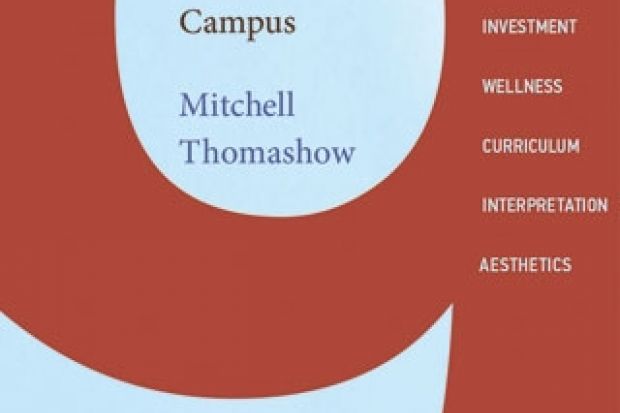This is a book that preaches to the environmental choir. If you are a fully signed-up member of the environmental movement, then Mitchell Thomashow’s book will meet with your general ideological approval. Written for college and university leaders, The Nine Elements of a Sustainable Campus aims to provide “guidance on the path to sustainability”. Note that if you substitute the word “salvation” for “sustainability” in the preceding sentence, then you will be not far off the prevailing tone of the book.
The book is based on the author’s experiences while serving as president of Unity College, a young, small (560 student), environmentally focused liberal arts college in rural Maine. As well as being evangelical at times, Thomashow’s book is also semi-autobiographical, with the author describing how he transformed the college between 2006 and 2011 via a series of sustainability projects ranging from the installation of solar panels and wind turbines to offering space for sustainability-inspired public art. Understandably, however, UK readers will wait to be convinced of the extent to which the lessons Thomashow learned can translate to the British sector.
The nine elements he discusses are energy, food, materials, governance, investment, wellness, curriculum, interpretation and aesthetics. As these provide the organising framework of the whole book, it would be interesting to have some discussion about how the author arrived at this classification. Also, what didn’t make the list? For example, why is there so little on the business case – return on investment, anyone? And why nine and not, say, five elements? It’s easy to see that it wouldn’t be a stretch to consider governance and investment under the heading of leadership, and to view wellness, interpretation and aesthetics as broader social issues.
My institution, the University of Greenwich, is a sustainability leader in UK higher education, and we have won a number of awards for our work on carbon emission reduction, recycling and championing green initiatives. From that perspective, of course, Thomashow’s book resonates with the work we undertake, and offers some valuable US insights that may be relevant and applicable to UK universities such as ours. It offers a bit of “how to” and a lot of “why” sustainability, with a number of useful examples. The insight of a university leader is particularly valuable, not least because the author has such a strong passion for sustainability transformation and a visionary perspective on what can be achieved with modest investment.
One of the book’s key strengths is that it recognises the clear role of leadership in applying sustainability and enabling students, academics and wider stakeholders to achieve important outcomes. Of particular interest is the wider perspective than that offered by many sustainability books, as it connects the importance of the social dynamics of higher education institutions and the potential for learning using the university as a laboratory. The focus on our sector, moreover, means that its examples are appropriate (which makes a pleasant change from the business-focused sustainability books that line the shelves of bookshops).
Surprisingly, however, this is quite a dense book, with no illustrations and only minimal signposting for the reader. The lack of intellectual context-setting in the introduction and a final discussion that brings everything together are significant omissions. It also becomes weaker when Thomashow’s writing style veers towards the overblown: “University leadership is our last best hope for addressing the global climate challenge, and campus sustainability initiatives are the foundation of that leadership.” He also has a tendency to overuse contemporary metaphors (“many modern readers prefer to ‘surf’. I have designed the nine elements so you can ride the waves”). These dilute the impact of the message and are especially unexpected given its intended audience of senior leaders (or, presumably, senior surf dudes).
Where the book is most over the top, however, is in a high-flown afterword by Anthony Cortese, organiser of the American College and University Presidents’ Climate Commitment. Not only is it never explained what the purpose of the afterword is and why it is an afterword and not a foreword, but here we are subjected to phrases such as: “Humanity is at a crossroads without historical precedent”; “all living systems are in long-term decline and are declining at an increasing rate”; “This is the greatest moral, intellectual, and social challenge that human civilization has ever faced”. Yikes. None of these grand phrases is unpacked, let alone substantiated. If this were a speech, it would be a peroration of truly Churchillian proportion. The afterword goes on to say that sustainability “provides a new focus, sense of urgency, and curricular coherence at a time of drift, fragmentation, and insularity in higher education”. And here’s me thinking that our advancements in research impact, social mobility, marketisation and employability were serving society in a meaningful way. To cap it all off, Cortese describes Thomashow’s work as a “beacon of hope in a sea of turbulence”. Really.
The Nine Elements of a Sustainable Campus
By Mitchell Thomashow
MIT Press, 256pp, £19.95
ISBN 97802620113
Published 3 April 2014
Register to continue
Why register?
- Registration is free and only takes a moment
- Once registered, you can read 3 articles a month
- Sign up for our newsletter
Subscribe
Or subscribe for unlimited access to:
- Unlimited access to news, views, insights & reviews
- Digital editions
- Digital access to THE’s university and college rankings analysis
Already registered or a current subscriber? Login





